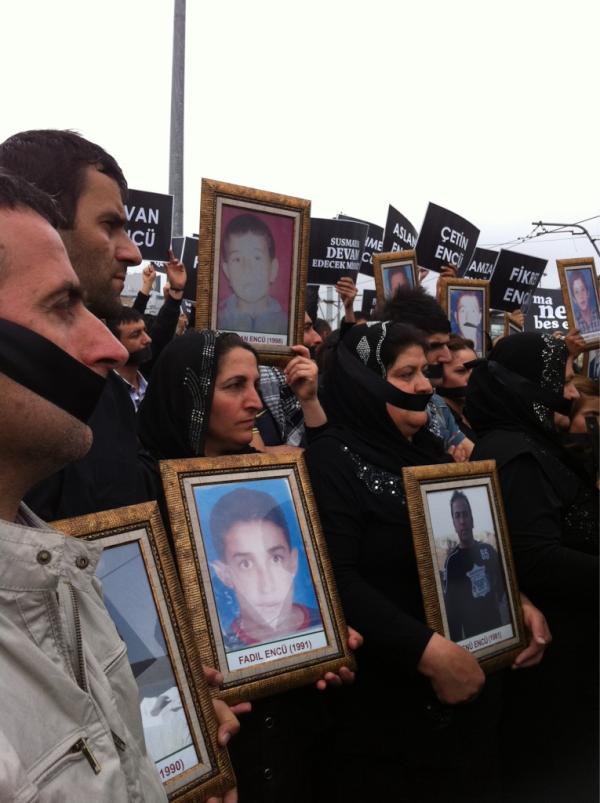The Turkish Protests the World Ignored
 In December of 2011, a group of 38 young Kurdish men were detected travelling through a smuggling route near the town of Uludere by an American predator drone. Not long after, a Turkish military jet flew over the same spot and dropped a bomb on the caravan. Of the group, 34 were killed. The attack was intended for PKK fighters, but the men — many of them teenage boys — were only civilians attempting to smuggle gasoline from Iraq into Turkey. The massacre was so vicious families looking for their loved ones couldn’t identify the remains. The slaughter signalled complete disregard by the Turkish government for Kurdish life. Erdogan’s response was seen as dismissive and insufficently repentant for the tragedy.
In December of 2011, a group of 38 young Kurdish men were detected travelling through a smuggling route near the town of Uludere by an American predator drone. Not long after, a Turkish military jet flew over the same spot and dropped a bomb on the caravan. Of the group, 34 were killed. The attack was intended for PKK fighters, but the men — many of them teenage boys — were only civilians attempting to smuggle gasoline from Iraq into Turkey. The massacre was so vicious families looking for their loved ones couldn’t identify the remains. The slaughter signalled complete disregard by the Turkish government for Kurdish life. Erdogan’s response was seen as dismissive and insufficently repentant for the tragedy.
When Kurds took to the streets in Diyarbakir in massive numbers to call for government accountability and a thorough investigation of the matter, police responded with violence. Protesters were attacked with police batons and tear gas, and they vollied back with stones and molotov cocktails. In Istanbul, more than a thousand Kurds flooded Taksim Square in anger, and police dispersed the crowd once more with tear gas and water cannons. In Ankara, Kurdish protesters peacefully carried images of the dead and rallied for an investigation into the incident.
Though these demonstrations of opposition were widespread and the calls by the Kurdish community for government accountability loud and constant, the event barely registered in Turkish media. Newspapers barely covered the attack. The news item only began making traction in Western media when the U.S.’s role in the massacre was revealed, and even then it was periphery news, a minor aside in bigger news on American-Turkish relations.
But these protests were larger in size and scope than the initial Gezi Park protests that have now enraptured the world. News analysts and journalists were quick to herald these recent demonstrations a “Turkish Spring” as Turkish activists attempted to stop the demolition of Taksim Square’s Gezi Park with protests, sit-ins and an occupation of the park. The display of defiance at Taksim Square inspired comparisons to Egypt’s Tahrir Square and even China’s famous Tiananmen Square. The protests have grown, galvanizing broad support all across Turkey, not just for the preservation of Gezi Park but for dramatic reforms in Prime Minister Tayyip Erdoğan’s administration. This, all spurred by an effort to save the trees that lined Gezi Park.
What makes these protests more worthy than the Uludere Massacre demonstrations? Kurdish protesters calling for the justice of their dead loved ones suffered the same response by Turkish police as did the Gezi Park protesters: water cannons, tear gas, batons. Kurds in Turkey have been participating in protests long before the Uludere Massacre, demanding reforms to Erdoğan’s government to stop the human rights violations of their community– and Taksim Square has long been the site of these protests. In April 2011, more than 2000 Kurdish protesters took to the square to condemn the Turkish elections board for banning 12 Kurdish politicians from running. Police pelted them with tear gas cannisters.
Kurds have born the brunt of police aggression for years, continuing to protest despite the threat of arrest, imprisonment and abuse, and seldom have non-Kurd Turks joined in the struggle. But it was the threat of the Gezi Park demolition, not the brutal death of 34 young Kurdish men, that compelled non-Kurd Turks to finally take to the square in anger. If media attention is any measure, the Gezi Park protests bear a stronger threat to the Erdogan administration than did the Kurdish protest for the Uludere victims. It’s a discouraging insight into the inferior appraisal of Kurdish lives by their fellow Turks — worse, it indicates a Turkish denial to legitimize Kurdish agency. Not only are Kurdish protests not afforded equal media coverage, they also don’t warrant support by their Turkish countrymen.
The Gezi Park protests could very well culminate into revolution. If anything the past few years has shown us, it’s that the power of protest is no easy thing to devalue. But it’s not just about bringing about change — it’s about the kind of change Turkey is willing to usher in. Change must be transformative; change must be all-inclusive. If a ‘changed’ Turkey looks like the same one we have now — a place hostile to its minorities — is it one worth fighting for at all?
Comments
Pingback: Kurdish News Weekly Briefing, 7 – 13 June 2013 « Peace in Kurdistan